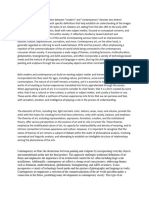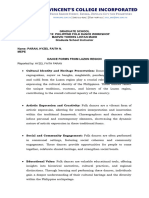Influence of Art On Society
Influence of Art On Society
Uploaded by
a8257448Copyright:
Available Formats
Influence of Art On Society
Influence of Art On Society
Uploaded by
a8257448Original Title
Copyright
Available Formats
Share this document
Did you find this document useful?
Is this content inappropriate?
Copyright:
Available Formats
Influence of Art On Society
Influence of Art On Society
Uploaded by
a8257448Copyright:
Available Formats
Influence Of Art On Society
Art, in its various forms, has been a powerful force throughout human history, influencing societal
values, sparking revolutions, and serving as a mirror reflecting the essence of culture. This essay
explores the profound influence of art on society, examining how creative expression shapes
perspectives, fosters change, and becomes a catalyst for cultural evolution.
Art as Cultural Expression: Art serves as a unique form of cultural expression, encapsulating the
values, beliefs, and emotions of a society. Whether through visual arts, music, literature, or
performance, artists channel the collective consciousness, providing a lens through which individuals
can explore and understand the cultural tapestry of their time.
Art as a Catalyst for Social Change: Throughout history, art has played a pivotal role in driving social
and political change. From political cartoons and protest art to music that becomes anthems of social
movements, artists have been at the forefront of advocating for justice, equality, and human rights.
Art has the power to inspire and mobilize communities, sparking conversations that lead to tangible
societal transformations.
Art and Individual Perspectives: Art has the ability to shape individual perspectives and challenge
societal norms. It encourages viewers and audiences to question assumptions, confront biases, and
see the world from different vantage points. This transformative quality of art contributes to
personal growth and fosters a more inclusive and empathetic society.
Cultural Identity and Artistic Heritage: Art serves as a repository of cultural identity and heritage.
Traditional art forms, passed down through generations, preserve the essence of a community's
history, values, and traditions. These artistic expressions connect individuals to their roots and
provide a sense of continuity in the ever-changing landscape of cultural evolution.
Art and Technology: In the contemporary digital age, technology has expanded the possibilities of
artistic expression. Digital art, virtual reality, and interactive installations redefine the boundaries of
creativity, offering new ways for artists to engage with audiences. Technology also enables the global
dissemination of art, fostering cross-cultural dialogue and collaboration.
Art as a Reflection of Social Issues: Contemporary artists often use their work to address pressing
social issues, from climate change and environmental sustainability to mental health and identity
politics. Artistic creations become a mirror reflecting the concerns and aspirations of society,
prompting critical reflection and collective dialogue.
Conclusion:
In conclusion, the influence of art on society is profound and multifaceted. As a dynamic force of
cultural expression, a catalyst for change, and a reflection of societal values, art plays a central role in
shaping the narrative of human experience. Recognizing the transformative power of art encourages
a deeper appreciation for its impact on societal dynamics and underscores the importance of
fostering a vibrant and inclusive artistic landscape for the benefit of present and future generations.
You might also like
- Manaakitanga EssayDocument11 pagesManaakitanga Essayapi-261880591100% (1)
- Assess The View That For Minority Ethnic Groups, The Practice of Religion and Membership of Religious Groups Is Mainly A Form of Cultural Defense.Document3 pagesAssess The View That For Minority Ethnic Groups, The Practice of Religion and Membership of Religious Groups Is Mainly A Form of Cultural Defense.Basil36958100% (1)
- Askerov Ali PDFDocument594 pagesAskerov Ali PDFElena RusuNo ratings yet
- The Role of Art in SocietyDocument1 pageThe Role of Art in Societyalyn63292No ratings yet
- The Role of Art in SocietyDocument1 pageThe Role of Art in Societylucia.gray.crimsonNo ratings yet
- Significance of Art in SocietyDocument2 pagesSignificance of Art in SocietyZofigan khawajaNo ratings yet
- Arts 1 Final PaperDocument8 pagesArts 1 Final Papermichellemariano629No ratings yet
- Art and Culture in WorldDocument3 pagesArt and Culture in WorldpyyamberNo ratings yet
- Supplemental Reading 1-CPARDocument4 pagesSupplemental Reading 1-CPARAngelu MalvarNo ratings yet
- Research 2Document1 pageResearch 2akhel baroniaNo ratings yet
- Arts 2Document1 pageArts 2akhel baroniaNo ratings yet
- The Role of Art in SocietyDocument2 pagesThe Role of Art in SocietysimonevoicoviciNo ratings yet
- ArtDocument2 pagesArtKyraaNo ratings yet
- The Importance of Art in SocietyDocument3 pagesThe Importance of Art in Societycapov18236No ratings yet
- Art EssayDocument2 pagesArt EssaymanufaceconsultantsNo ratings yet
- The Role of Art in SocietyDocument1 pageThe Role of Art in Societymandykins26No ratings yet
- Essay 11Document1 pageEssay 11sabic.amna.21No ratings yet
- ArtisticDocument1 pageArtisticzondiolwethu674No ratings yet
- ### The Role of Art in SocietyDocument2 pages### The Role of Art in Societyjc1545313No ratings yet
- The Importance of Being An ArtistDocument2 pagesThe Importance of Being An Artistmert yigidNo ratings yet
- What Is ArtDocument1 pageWhat Is Artemma abissaNo ratings yet
- EssayDocument3 pagesEssaydenniseescobido07No ratings yet
- Visual Art First ActivityDocument2 pagesVisual Art First ActivityMark Kenneth CeballosNo ratings yet
- Courher 7Document1 pageCourher 7cyrilleNo ratings yet
- The Significance of Art and Culture in SocietyDocument1 pageThe Significance of Art and Culture in SocietyAngBagong Barangay SanJuanNo ratings yet
- Arts Impact On Political and Economic DiscouresDocument19 pagesArts Impact On Political and Economic DiscouresLaksha ChoudharyNo ratings yet
- ToK Art EssayDocument3 pagesToK Art EssaymcdowbokeNo ratings yet
- He Role of Art in SocietyDocument1 pageHe Role of Art in Societyandrei 123No ratings yet
- Art AppreciationDocument1 pageArt AppreciationKaela LorNo ratings yet
- The Transformative Power of ArtDocument2 pagesThe Transformative Power of ArtAracely Samira Curo TevesNo ratings yet
- Art and CultureDocument6 pagesArt and Culturemonakhanawan12345678No ratings yet
- The Role of Art in SocietyDocument2 pagesThe Role of Art in SocietyMarco ArionoNo ratings yet
- What Are Fine ArtsDocument7 pagesWhat Are Fine ArtsTeklemariamNo ratings yet
- Assumptions of ArtDocument3 pagesAssumptions of ArtGail EmbudoNo ratings yet
- ArtsDocument2 pagesArtspooandpeelolNo ratings yet
- Week 2 062Document6 pagesWeek 2 062praneethyadav5432No ratings yet
- Iaf 2Document6 pagesIaf 2praneethyadav5432No ratings yet
- Art Defines CultureDocument5 pagesArt Defines Culturesimbarashe chikopfaNo ratings yet
- In The Realm of ArtDocument3 pagesIn The Realm of ArtSweetrose GonzalesNo ratings yet
- MypdfDocument1 pageMypdfdanielznorton20No ratings yet
- The ProposalDocument5 pagesThe ProposaliamrowlandxNo ratings yet
- What Is Social ArtsDocument1 pageWhat Is Social Artsjgv2197No ratings yet
- Humanities The ArtsDocument3 pagesHumanities The Artsangelasanthosh431No ratings yet
- Stufff InspooDocument10 pagesStufff InspooLuv SkylerNo ratings yet
- This Is ArtDocument2 pagesThis Is ArtAbdeljalil FenniriNo ratings yet
- Art Culture and SocietyDocument9 pagesArt Culture and Societygeloypernecitaesmena100% (1)
- Role of An Artist in SocietyDocument2 pagesRole of An Artist in SocietygeloypernecitaesmenaNo ratings yet
- Ensayo InglesDocument1 pageEnsayo InglesAlex EmmanuelNo ratings yet
- ArtsDocument7 pagesArtsDonkylaNo ratings yet
- The Role of Cinema and Art in Shaping Communities. Andrei ZAPSADocument4 pagesThe Role of Cinema and Art in Shaping Communities. Andrei ZAPSAAndrei GS ZapshaNo ratings yet
- The Role of Art in SocietyDocument2 pagesThe Role of Art in SocietyshijovargheseNo ratings yet
- The Importance of Art To SocietiesDocument4 pagesThe Importance of Art To SocietiesRewanNo ratings yet
- Power of ArtDocument2 pagesPower of Artlozaha70No ratings yet
- The Power of Art A Journey Through Creativity Expression and InspirationDocument2 pagesThe Power of Art A Journey Through Creativity Expression and Inspirationradin alifiNo ratings yet
- Art in The HomeDocument8 pagesArt in The HomeSonny Boy SajoniaNo ratings yet
- Reading Report 123 Act 4Document5 pagesReading Report 123 Act 4De Leon Patricia A.No ratings yet
- Ge 6Document15 pagesGe 6Chaila Jane Pasquil SabelloNo ratings yet
- ArtDocument1 pageArtlkjhg ghjklNo ratings yet
- We The Artists... - Kolkata International Dance FestivalDocument3 pagesWe The Artists... - Kolkata International Dance Festival(KIDF) Kolkata International Dance FestivalNo ratings yet
- Arts Culture Concept PaperDocument2 pagesArts Culture Concept PaperUla Deru0% (1)
- Art As A Branch of HumanitiesDocument2 pagesArt As A Branch of HumanitiesHansa MandhwaniNo ratings yet
- Modern ArtDocument4 pagesModern ArtrengaboyfiesNo ratings yet
- The New Renaissance: How Art, Culture, and Tech Are Shaping Tomorrow’s WorldFrom EverandThe New Renaissance: How Art, Culture, and Tech Are Shaping Tomorrow’s WorldNo ratings yet
- Sma14 4849 PDFDocument341 pagesSma14 4849 PDFAfzal ImamNo ratings yet
- Family Values in Vietnam Past Present: Group 7Document34 pagesFamily Values in Vietnam Past Present: Group 7Vi VuNo ratings yet
- Gec 5 PPT Midterm WK 2 4 Communication and GlobalizationDocument32 pagesGec 5 PPT Midterm WK 2 4 Communication and GlobalizationJean BalaticoNo ratings yet
- Đề Số 30 Có Giải Chi TiếtDocument18 pagesĐề Số 30 Có Giải Chi TiếtLinh Tran ThuyNo ratings yet
- Globalisation Will Eventually Lead To A Complete Loss of Cultural IdentityDocument2 pagesGlobalisation Will Eventually Lead To A Complete Loss of Cultural IdentityKaungPyae SoneNo ratings yet
- A Key To Dutch HistoryDocument229 pagesA Key To Dutch HistoryAngel Iulian Popescu100% (1)
- Unit Title: Law & Citizens Citizenship, Diversity & Identity Year Level: Grade 7Document4 pagesUnit Title: Law & Citizens Citizenship, Diversity & Identity Year Level: Grade 7api-298200210No ratings yet
- Intercultural CommunicationDocument20 pagesIntercultural CommunicationRenz Pelayo100% (1)
- Chris Kortright: Colonization and IdentityDocument15 pagesChris Kortright: Colonization and IdentityBloomNo ratings yet
- AuditDocument15 pagesAuditSaniya BondeNo ratings yet
- Cultural Solypsism, National Identities and The Discourse of Multiculturalism in Australian Picture BooksDocument16 pagesCultural Solypsism, National Identities and The Discourse of Multiculturalism in Australian Picture BooksRogers Tabe OrockNo ratings yet
- What Is Cultural IdentityDocument3 pagesWhat Is Cultural IdentityalinamonicaNo ratings yet
- Capstone Project Proposal DraftDocument9 pagesCapstone Project Proposal Draftapi-650759265No ratings yet
- Chapter 2 MulticulturalismDocument32 pagesChapter 2 MulticulturalismSînziana SmutzerNo ratings yet
- Language FoodDocument19 pagesLanguage FoodSri Thoat MulyaningsihNo ratings yet
- Managing Urban IdentitiesDocument5 pagesManaging Urban IdentitiesGabriella YiuNo ratings yet
- Manuel Castells - Local and Global (Cities in The Network Society)Document11 pagesManuel Castells - Local and Global (Cities in The Network Society)CleoatwarNo ratings yet
- Rediscovering AmericaDocument247 pagesRediscovering AmericainhidoquiNo ratings yet
- Toronto Police Service Mental Health and Addiction StrategyDocument28 pagesToronto Police Service Mental Health and Addiction StrategyCityNewsTorontoNo ratings yet
- OYK 2011-SummitReportDocument90 pagesOYK 2011-SummitReportOwais AsifNo ratings yet
- Slownik TypografiaDocument1 pageSlownik TypografiaAnonymous pg2tCmmAyzNo ratings yet
- (2019) 消费者文化认同:本地和全球文化认同和衡量意义Document18 pages(2019) 消费者文化认同:本地和全球文化认同和衡量意义张苡铭No ratings yet
- Fundamentals of Folk Dance TechniqueDocument5 pagesFundamentals of Folk Dance TechniqueHyzel Faith ParanNo ratings yet
- Cultural Competence ManualDocument196 pagesCultural Competence Manualtalbotbruce2122100% (5)
- QaaoDocument46 pagesQaaonastia.grijalva0No ratings yet
- Dance Forms From Luzon RegionDocument4 pagesDance Forms From Luzon RegionHyzel Faith ParanNo ratings yet
- Culture and Identity (4) PPTXDocument13 pagesCulture and Identity (4) PPTXأحمد حمادNo ratings yet

























































































